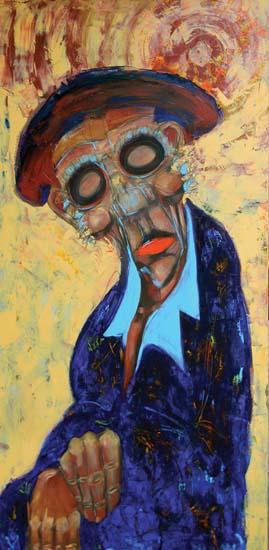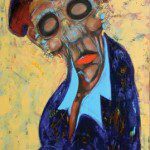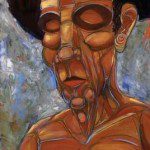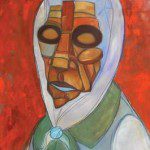Ari is a trained draftsman, and it shows in his series, “Place Names,” showing at the Parish Gallery in Georgetown, November 19-30. Ari’s paintings are “old school”—stripped of flash, subject matter irony and mixed media techniques of many painters showing today. The work is straight oil paining: pigment, linseed oil, turpentine and board, all applied with earnest, grit and hard labor.
This body of work is partially inspired by a combination of the painter’s Jewish heritage, a recent trip to Israel and a search for universal spirituality. Ari comments: “My great grandparents on both sides were born in small villages scattered throughout what is now Latvia, Poland and Russia, almost all of which were wiped out over the last century. When even these scraps of history are lost, what becomes of the ancestral traditions and beliefs? And what do they then mean? With cultures so violently uprooted and jostled, what is there to look back to?’’
Ari’s family history is one of migration, and his pieces are an expression of this background. He addresses the tragedy of these vanished places directly. As the show’s name implies, the titles of these paintings are largely drawn from Jewish Shtetls, or townships, from Latvia and Poland, most of which were wiped out during the Bolshevik Revolution and World War II. Along with the towns, centuries of tradition and heritage were lost to its people.
One of two larger pieces, “Bauske,” features three well-placed figures that crowd the space of the canvas. Two of the figures, contemplative in appearance, are juxtaposed and nearly mirror each other. A third, more youthful figure casts an open gaze that creates a psychic and visual contrast, which I read as knowledge of a fate that the two dominant figures are resigned to or unaware of. The reddish circular areas above each figure reflect an eternal presence, perhaps their souls.
This sense of displacement sits deep in Ari. His mother hails from South Africa, where her grandparents migrated from Eastern Europe. Immigrating to this country, she brought with her African masks, carvings and paintings, which Ari has viewed since childhood. Carried dormant in his memory for years, remnants of these images are revealed in his own paintings. This element of Ari’s work causes me to recall Richard Deibenkorn’s comments about composing from recollections of Bayeux Tapestry reproductions given to him in his childhood by his maternal grandmother.
Ari paints the gnarled hands and contemplative faces in the pictures in a direct manner. The anatomical aspects of the paintings are modeled to volume using interlocking and flowing flat planes, accented by strong graphite or etched lines. There is a sense of wood carving simply in the manner that Ari builds dimension in his figures. Additionally, much of the color of the work is earthy, perhaps akin to the colors of his mother’s African pieces. Ari’s work resonates with a viewer familiar with expressionist and possibly cubist work done before 1930, yet the style is unique and surprising.
Aside from the mystical intrigue of the contemplative figures and the unique manner that Ari paints, his painting “Zagare” stands out for its color composition of black, red and green. The figure’s massive blue-black beard and head covering weigh well against the carefully crafted red shape of the garment and the receding greenish-blue background, which are painted with equal thoughtfulness and care. The overall effect Ari creates in this and other pieces is one of separate elements subordinated to the organic whole of the image. One almost overlooks the delightful way the fingers of the sitter in “Zagare” rest on the cane he is holding.
This series of paintings provides a first look into the work of a young, ambitious painter. With unlimited potential and a deep reservoir of talent, Ari will no doubt produce much more work.
Ari Post’s exhibition, “Place Names,” will be showing at the Parish Gallery in Georgetown from November 19-30, with an opening reception on the 19th from 6-8 p.m. For more information visit www.ParishGallery.com.







I just bought a painting from Ari Post,at an auction,and would like to know where I can find more of his work please.